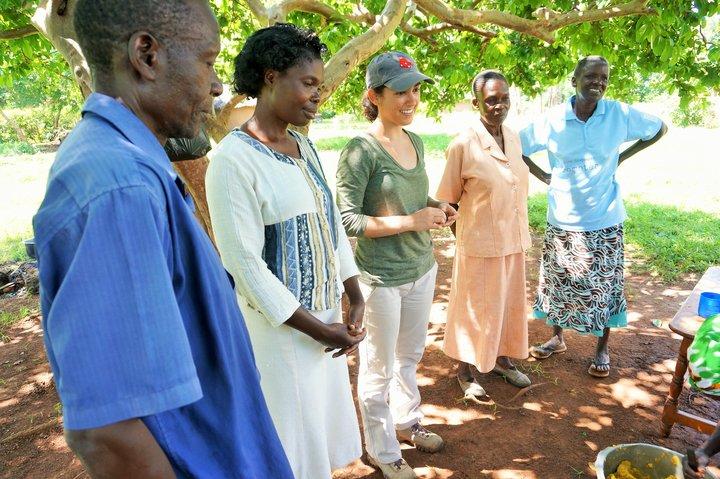Biodiversity for Food and Nutrition in Busia County, Kenya

Alessandra Grasso, US Borlaug Fellow reports on her experiences working with rural communities in Busia, Kenya, as part of the biodiversity for food and nutrition initiative.
A report by Alessandra Grasso, US Borlaug Fellow
“Whe! You are fat!” Coming from a country that has a stereotype of people being fat, I was at first taken aback when my new friend exclaimed this when she met me. Where I come from, if someone calls another fat, it isn’t nice. But in Busia, a rural town in Western Kenya, I learned that being called fat is a compliment. I also quickly learned that this phrase is becoming archaic, as fat once meant healthy. However, obesity is on the rise in an area still stricken with undernutrition and chronic diseases such as diabetes and high blood pressure are becoming more prevalent. I found this dichotomy of obesity and undernutrition hard to understand, especially in a place rich in diversity with regards to foods, landscapes and cultures.
According to 2008-2009 Kenya Demographic Health Survey, 34 per cent of children under five years of age in the western region, including Busia County, are stunted, and micronutrient deficiencies, such as vitamin A and iron deficiencies, are widespread. Cross-cutting issues that remain in Busia County include poverty, HIV/AIDS, gender, climate change and environmental conservation. The Biodiversity for Food and Nutrition (BFN) team in Kenya1 is responding to the high rate of malnutrition and addressing these cross-cutting issues through private-public sector implementation of garden demonstrations at primary and secondary schools, healthcare facilities and with smallholder farmers.
With my finger on the shutter of my camera, notepad tucked under my arm and pen in my mouth, I spent five months in Busia meeting and talking with farmer groups, self-help groups, students and teachers from primary and secondary schools, local government officials, community health workers and agriculture extension workers to obtain an understanding of attitudes, beliefs, activities, problems, persistent challenges and opportunities the field. I learned that there was a lack of awareness of the nutritional value of agricultural biodiversity, and thus foods rich in protein, vitamins and minerals are underutilized and in some cases on the brink of extinction. “I sell milk and kunde (cowpea leaves) [or other African leafy vegetables] at the market, and buy mandazi (fried dough) for my children” is a common quote I heard from mothers.
 The Kenya BFN Project Implementation Site Committee2 is undertaking garden demonstrations at primary and secondary schools, healthcare facilities and with farmer groups in seven sub-counties to build the capacity of institutions and individuals to practice kitchen gardening technologies, such as mandala, keyhole and Tumbukiza gardens, and sustainably grow and utilize an array of nutritious local foods. With 21 established garden demonstrations, the BFN team is making headway in increasing the number of farmers applying improved technologies and management practices and in creating the number of families growing, eating and preserving foods that were once grown and eaten by earlier generations.
The Kenya BFN Project Implementation Site Committee2 is undertaking garden demonstrations at primary and secondary schools, healthcare facilities and with farmer groups in seven sub-counties to build the capacity of institutions and individuals to practice kitchen gardening technologies, such as mandala, keyhole and Tumbukiza gardens, and sustainably grow and utilize an array of nutritious local foods. With 21 established garden demonstrations, the BFN team is making headway in increasing the number of farmers applying improved technologies and management practices and in creating the number of families growing, eating and preserving foods that were once grown and eaten by earlier generations.
I believe the BFN team can achieve much by the end of 2017. I participated in a few policy meetings and observed high commitment from both local and national government officials in drafting policies for better conservation and sustainable use of biodiversity. The BFN Project in Kenya has built up strong momentum and recently leveraged support for two grants and funding for policy work in Busia. These grants are focused in understanding and addressing supply and demand constraints to introducing nutritious vegetables and fruits into primary school feeding programs in Kenya, and on developing value chains for conserving local biodiversity and improving diets.
The greatest personal accomplishment as a U.S. Borlaug Fellow was connecting with the farmers, women, and children and gaining trust in the community. During my time in Busia, I always made an effort to role model healthy behaviours. I was invited to attend community gatherings, such as self-help group meetings, farmer group meetings and Madaraka Day celebration, to share observations made during my time as a researcher in Busia and to lead discussions in applied nutrition principles and strategies. I arrived in Kenya as Alessandra, and left with my new locally-adopted name - Nanjala.
To find out more, please read my three stories from the field:
- School gardening in Busia, Kenya
- Health units in Busia County, Kenya
- Demonstration gardens in Busia, Kenya
Notes:
My gratitude goes out to Dr. Danny Hunter (research mentor, Bioversity International), Teresa Borelli (Bioversity International), Dr. Victor Wasike (KALRO), Dr. Ann Yelmokas McDermott (University advisor, JHSPH), Dr. Keith West (JHSPH) and William Buluma (SINGI CBO) who were all indispensable mentors during my time as US Borlaug Fellow.
1Members drawn from Kenya Agriculture and Livestock Research Organization (KALRO), Ministries of Health, Agriculture and Education, National Museums of Kenya, Jomo Kenyatta University, Egerton University and Kenya National AIDS & STI Control Program (NASCOP)
2Members drawn from KALRO, county-level departments of health, agriculture and education and Sustainable Income Generating Investment (SINGI) community-based organization (CBO)
*The GEF 'Mainstreaming biodiversity for nutrition and health' initiative is led by Brazil, Kenya, Sri Lanka and Turkey and coordinated by Bioversity International, with implementation support from the United Nations Environment Programme (UNEP) and the Food and Agriculture Organization of the United Nations (FAO) and additional support from the CGIAR Research Program on Agriculture for Nutrition and Health.
